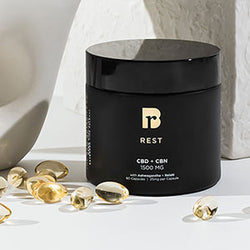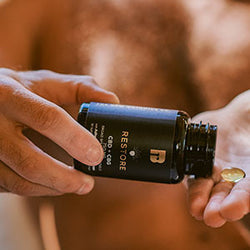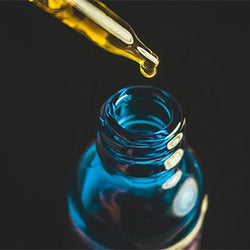You, my friend, are half mushroom. No, you’re not the gilled cap of a spore-bearing toadstool peeking up from a forest floor. You are a human being—that pompous primate who is a truly terrible neighbor to everyone else in the animal kingdom. But you do share almost 50%of the same DNA with mushrooms. On one hand, that’s a pretty unremarkable stat: We also share 61% DNA with a fruit fly and 85% DNA with a mouse. Yet some scientists think that humans have co-evolved alongside mushrooms, in part because the human body has immune cell receptor sites that absorb polysaccharide compounds found only in fungi.
CBN Tinctures & Softgels with Functional Mushrooms
At The Raw Botanics Co. all of our CBD, CBN, CBG, and CBC products have at least one functional mushroom as a key ingredient and how we select that mushroom depends on the specific need we are addressing. For instance, we pair our CBN sleep aid "REST" with reishi which is praised for its stress reducing benefits.
Mushrooms as Adaptogens
Cultures around the world have also used mushrooms medicinally for thousands of years, so it’s no wonder that we’re still using them today—lots of them. Sales of mushrooms in the US reached nearly $5 billion in 2017 as people are getting back to their roots and enjoying the au naturel benefits of this primordial superfood. Many mushrooms are adaptogens, which are a core component of our product offerings, so allow us a moment to make a well-rounded case for how the current mushroom boom can improve your wellbeing.
What Are Functional Mushrooms?
As much as we’re going to rave about mushrooms in this blog, please do note that we’re not advising you to pluck up a rando mushroom that you see half-hidden under leaves strewn along a hiking trail and pop it in your mouth. That mushroom might be a white button mushroom that you can buy at the store and mix into a chicken marsala. Or that mushroom might be the death cap mushroom, which will cause you to vomit, expel bloody diarrhea, and keel over with body-rocking abdominal pain.
Not all mushrooms are created equal. The mushrooms that we use in Raw Botanics products are functional mushrooms—the rare ones that grow in virgin forests, atop tumbled logs, or on the heads of caterpillars in Himalayan plateaus. As we mentioned earlier, many functional mushrooms are considered to be “adaptogenic.” We’ve written about adaptogens before—they’re non-toxic plants that tend to grow in extreme environments (like the Himalayas), where they develop phytonutrients that help them adapt to harsh ecological conditions such as prolonged heat or freezing temperatures or high altitudes. As adaptogens, functional mushrooms can aid in our bodies’ healing processes and help us counteract stress.
Types of Functional Mushrooms
Here a rundown of some of the functional mushrooms—some famous, some niche, and many of which we incorporate into Raw Botanics products:
- Cordyceps: Gym goers, athletes, and fitness gurus round the world celebrate cordyceps sinensis for its capacity to increase your energy output—boosting stamina levels and aiding in your post-workout recovery regimen.
- Reishi: A traditional medicine in Asia, reishi can improve blood circulation, support healthy gut flora, and assuage many external skin conditions. For the last few decades, reishi has been approved in China and Japan as an addition to standard cancer treatments.
- Chaga: In World War II, chaga was used as a coffee ration because of its color and robust flavor, but it’s more than a substitute for your morning tar—it can also help treat chronic gastritis and duodenal ulcers, and studies have shown that patients with psoriasis who ingest chaga reported a 76% cure rate. (An additional 16% of those patients attested to an improvement in their symptoms over time.)
- Turkey Tail: You can find these polypores—that is, fungi that grow their more edible portions on their undersides—mostly flourishing on fallen dead trees. Turkey tail is full of prebiotics and antioxidants, and studies indicate that its extract may be useful as an adjunctive cancer therapy.
- Lion’s Mane: High in antioxidants, with potential anti-inflammatory properties, lion’s mane is perhaps best known for its ability to provide benefits to your brain, especially sharper focus and better memory. Some animal studies have shown that it could help prevent cognitive diseases like Parkinson’s and Alzheimer’s—although more research is needed to determine whether it can treat human manifestations of those diseases.
- Maitake: “Dancing mushroom.” That’s the Japanese translation of “maitake,” which is (anecdotally) so named because it will make you dance for joy if you come across it. An adaptogen, and stocked with potential anti-cancer properties, this little mushroom may be able to help treat your cholesterol and type 2 diabetes. Research indicates that it can also support your immune system better than any other mushroom.
- Shiitake: Countless generations have used this world-famous fungi in Chinese folk medicine, in part because it can be eaten raw or cooked into a bevy of dishes. Shiitake mushrooms contain seven of the nine essential amino acids, and they may help combat inflammation and reduce cholesterol.
- Enokitake: Primarily found in Korea, China, and Japan, this delicate white mushroom comes packed with enough flavor to enhance a range of dishes—stir-fry, tempura, beef rolls, and mushroom pancakes among them. Enokitake is a robust antioxidant and contains niacin, a form of vitamin B3 that the body needs to maintain healthy cells.
- Tremella: They don’t call tremella the “beauty mushroom” for nothing. This mushroom, which resembles a crystallized bath sponge, is a superfood with water-retaining properties that can rejuvenate your skin. Containing more vitamin D than any other food source on the planet, tremella is also loaded with antioxidants and fiber.
- Oyster: According to recent studies, popping this type of oyster in your mouth might help decrease your risk of cancer, obesity, diabetes, and heart disease.
By this point, if you’re thinking, ‘I doubt that mushrooms are some mystical remedy for all my worldly ills,’ rest assured: We doubt it, too. We’ll slip in here the same proviso that we included in our blog on adaptogens: These things work, but they’re not cure-alls.
Actually, functional mushrooms fulfill a function that’s the opposite of a quick-fix pill. So much of US healthcare—as we’re sure you know—is reactionary. Think of the veritable warehouses of antibiotics and stimulants that doctors in this country prescribe to patients every day. Many of those prescriptions are effective. But many are also intended to assuage symptoms or mitigate pain rather than address root causes. One reason that ayurvedic medicine inspired much of the foundational thinking at Raw Botanics is because those practices place an emphasis on the longevity of wellbeing—an emphasis so often lost in the quick-fix-pill culture that we live in.
Functional mushrooms are not substitutes for modern medicine. But bear in mind that fungi helped produce some of our most renowned modern medicines, such as penicillin and many statins. Mushrooms are high in protein and low in calories, but their chief endorsement is the extent to which they fortify our immune systems, which contain a galaxy of cells, including this list of cells we’re about to wallop you with: T-cells, cytokines, neutrophils, lymphocytes, macrophages, and natural killer cells (NK). Mushrooms boost the activity of all those microorganic warriors who are protecting us from bacteria, viruses, pathogens, and toxins. As they say, fight fungi with fungi.
How to Take Them
Google “functional mushrooms,” and you’re likely to witness not a few paid ads popping up for capsules or extracts or coffee alternatives. One reason that you’re getting blasted with those product lines is the relative rarity of these mushrooms. You might spy boxes of shiitake on the shelves of a big box store, but enokitake? Tremella? Lion’s mane, reishi, chaga? Certainly not. So unless you’ve got a greenhouse out back where you cultivate bespoke mushrooms, or you frequent that hole-in-the-wall minimart with arm-deep troughs full of this stuff—or you’re going to the Himalayas and have a knack for spotting caterpillars that balance mushrooms atop their heads—then you can expect to buy most of these mushrooms as supplements.
That’s right, supplements—capsules that you can pop like pills, extracts that you can drink like hot cocoa, or powders that you can mix in with a smoothie or a protein shake. For a more elevated experience, you can also order our tinctures, softgels, pillow and mask mists, and topicals that contain reishi, lion’s mane, chaga, or cordyceps and turkey tail.
What to Look For
As you’re perusing your local Ye Ole Vitamin Shoppe for their latest shipment of mushroom hot chocolate, cast a wary eye over the percentage of starch in the ingredients. Mushroom supplements, you see, are often puffed up with “filler” in the form of starch. Anything with less than 5% starch is okay. Anything over, and you’re probably paying for filler.
Steer clear of supplements with mycelium (grain spawn) in them, which essentially means that they contain no beta-glucan—complex long-chain sugars that give mushrooms much of their medicinal power. Instead, look for the labels that mention fruit body, fruiting body, polysaccharides and triterpenoid compounds.
Companies that sell grain spawn as a health product commonly refer to it as mycelium or mycelium biomass.
Grain spawn is not a mushroom, and it is most emphatically not a genuine medicinal mushroom product. Any product that contains the ingredients "mycelial biomass, myceliated grain, cultured oats, or even freeze-dried myceliated brown rice" should be avoided.
Finally, bear in mind that manufacturers and distributors do not need to secure FDA approval to sell dietary supplements. So you should only buy from a trusted brand, preferably one that’s transparent about their testing practices and extraction methods. Even with supplements that are stocked with real mushrooms, budget at least two weeks to see any effects (lest you fear that you’ve been duped into purchasing some modern panacea).
The Gift of the Fungi
Mushrooms have overgrown the wellness space these days, and while it’s tempting to dismiss this proliferation of macrofungi as another fad or jag flourishing atop a pile of manure, our take on this trend is that it can teach us a lot about how to stay healthy. People have foraged deep in the woods for wild mushrooms since time immemorial, and the dishes they’ve created with them are some of the most beloved culinary experiences in history—coq au vin, risottos and rigatonis, pork brisket served with peaches and serrano peppers and golden chanterelles. No, one bite of the mushroom and all your troubles won’t go away. But mushrooms are among the most nutritious edible substances on the planet, and making them a regular ingredient of your meals or taking them as a supplement can help sustain you in good health for years to come.
We carry a variety of products containing functional mushrooms including:
- CBC tinctures
- CBN tinctures
- CBG tinctures
- CBD tinctures
- CBC softgels
- CBN softgels
- CBG softgels
- CBD softgels







